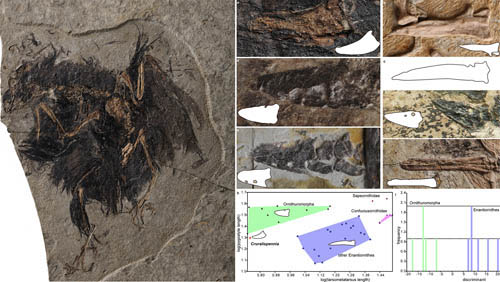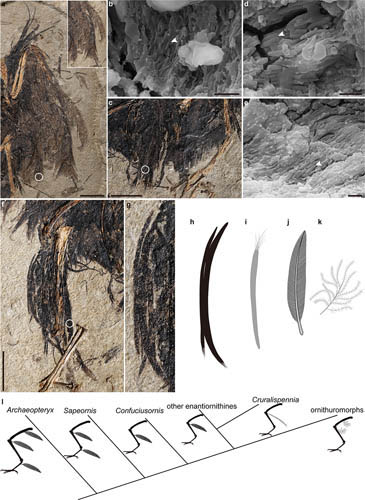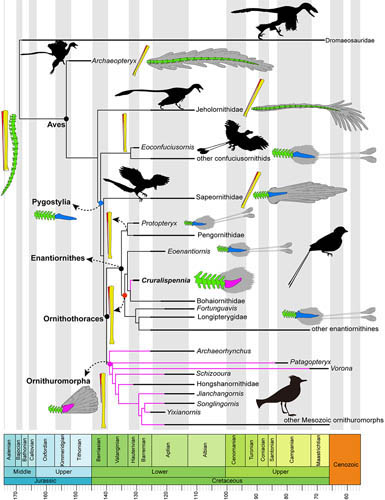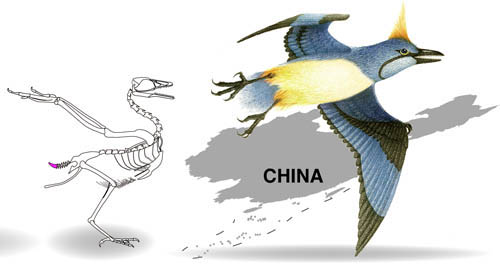On February 1, Wang Min, Zhou Zhonghe, Zou Jingmei of the Institute of Vertebrate Paleontology and Paleoanthropology, Chinese Academy of Sciences, and Pan Yanhong of the Nanjing Institute of Geology and Paleontology reported in Nature Communications a discovery of 130 million The Early Cretaceous enantiornithide Cruralispennia multidonta (Cruralispennia multidonta) discovered two years ago revealed that the caudal bones and tail feathers were independent of each other in the early evolution of birds, and also discovered a type of feathers with special shapes.
Enantiornithes are the most successfully evolved group of birds in the Mesozoic Era and constitute the sister group of modern ornithomorphs (all living birds evolved from modern ornithomorphs). The new fossil was discovered in the Huajiying Formation 130 million years ago. Although it is one of the oldest known enantiornithids, Neopteryx has preserved many progressive features, including two pairs of protrusions on the posterior edge of the sternum, degeneration of the minor wing digits, shortening of the fibula and pygophyseal bone, etc., which are obviously different from those of its contemporaries. Other birds discovered in this layer; the new bird's lower jaw has 14 teeth, which is the largest number of teeth in the enantiornithine known so far, revealing that a large number of morphological differences have already appeared in the early stages of enantiornithine evolution.
During the evolution from dinosaurs to birds, the tailbone changed most significantly. Unlike the long tail bones of dinosaurs, the tail bones of living birds are significantly shortened, especially the last few tail vertebrae that fuse into a pygostyle. The pygodontium of living birds is plow-shaped when viewed from the side, and its surface is attached with muscles and fibrous fat to control the expansion and closing of fan-shaped tail feathers, forming an important part of flight. Previously, such plow-shaped tail feathers only appeared in modern ornithomorphs, and fan-shaped tail feathers were mostly found in modern ornithomorphs; on the contrary, they were found in enantiornithes and other more primitive birds (such as Confuciusornis and Birds), the caudal bone has a single morphological structure and is rod-shaped, especially the end does not bend dorsally, and the relative length is significantly larger than that of modern birds, so their caudal bone is simply the result of shortening the coccyx. , and fan-shaped tail feathers are rarely found in these birds. Therefore, researchers generally believe that the plow-shaped caudal bones and fan-shaped tail feathers evolved simultaneously. However, the discovery of the polytoothed bird challenges this view. The pygodontium of Polytodontidae was significantly shortened, and its relative length was similar to that of today's ornithids. More importantly, the end of the pygotype is bent dorsally, forming a plow-shaped pygotype that is exactly the same as that of today's birds. The researchers used discriminant analysis to construct the morphological space of the caudal bones of Mesozoic birds, and also confirmed that the caudal bones of the polytoothed tibial bird are closer in shape to the pygoidal bones of modern birds. However, the polytoothed bird does not have fan-shaped tail feathers; instead, its tail feathers are all non-flabulate, suggesting that the ornithomorphic caudal pelvis arose through parallel evolution in at least one enantiornithine group. , and the hypothesis of "co-evolution of plow-shaped caudal hedrum-fan-shaped tail feathers" needs to be reconsidered.
Researchers have observed a strange type of feathers on the tibiotarsal bones of the multi-toothed tibialis. These feathers are about 12-16mm long and are linear in shape overall, but have small branches scattered at their extreme ends. The researchers believe that these small terminal branches represent a single barb, with the main part of the barb fused to form the rachis and diverging only at the tip. The hindlimb feathers of birds mainly come in two forms: pinnae and down feathers. The hindlimb feathers of the multi-toothed tibial bird mentioned above are different from the morphological structure of all known living or fossil feathers, and represent a type of feather evolution. Extinct feather morphology - proximally wire-like part with a short filamentous distal tip (PWFDTs). By conducting scanning electron microscopy observations on the feathers of multi-toothed tibialis, the researchers found that the chromatophore morphology of the tibiotarsal feathers was significantly different from that of feathers on other parts of the body, and the geometric shape of the chromatophores was related to their color, indicating that these tibiotarsal feathers Feathers come in different colors. The tibiotarsal feathers of polytoothed tibialis obviously do not have an aerodynamic effect, and their structure is different from that of down feathers, indicating that their thermal insulation effect is limited. Therefore, researchers speculate that such feathers may be used to attract the opposite sex. It also corroborates with the different colors reflected by the chromatophores.
In addition, the multi-toothed tibia also provides other important information on the evolution of features, such as the shortening of the fibula, which represents the earliest appearance of this progressive feature. Observation of the microstructure of its bones led the researchers to speculate that the polytoothed bird could reach adulthood in about a year, unlike the slow growth pattern of other enantiornithids. Through the study of the phylogenetic relationship of Mesozoic birds, Polytodontidae has been classified as a more advanced enantiornith, which is inconsistent with its relatively ancient strata. By estimating the divergence time of the main lineages, the discovery of the multi-toothed shankbird made the origin and divergence time of the main bird lineages in the Early Cretaceous much earlier than previously thought.
This research was funded by the National Natural Science Foundation of China and the Strategic Priority Science and Technology Project of the Chinese Academy of Sciences (Category B).

Figure 1 Comparison of the holotype fossil of Cruralispennia multidonta and the caudal bones of Mesozoic birds (photo provided by Wang Min)

Figure 2 Feathers and chromatophores of polytooth tibialis, restoration of tibiotarsal feathers, and evolution of hindlimb feathers in early birds (photo provided by Wang Min)

Figure 3 Mesozoic bird phylogenetic tree, showing the divergence time of the main branches and the main evolution of the caudal bones and tibia and fibula (photo provided by Wang Min)

Figure 4 Reconstruction of the multi-toothed shank bird (Photo courtesy of Shi Aijuan and Wang Min)
animal tags: enantiornithes birds evolution Cretaceous pododontids fossils
We created this article in conjunction with AI technology, then made sure it was fact-checked and edited by a Animals Top editor.